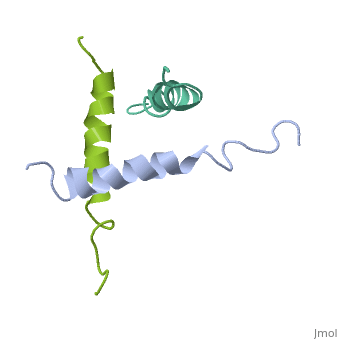Glucagon: Difference between revisions
Michal Harel (talk | contribs) No edit summary |
No edit summary |
||
| Line 2: | Line 2: | ||
== Function == | == Function == | ||
'''Glucagon''' (GLC) is a hormone which raises blood glucose level. GLC causes the liver to convert glycogen to glucose. GLC effect is opposite to that of insulin<ref>PMID:21824265</ref>. See some details in [[User:Mary Ball/Glucagon]]. | '''Glucagon''' (GLC) is a hormone which raises blood glucose level. GLC causes the liver to convert glycogen to glucose. GLC effect is opposite to that of insulin<ref>PMID:21824265</ref>. Cells sense the presence of glucogon through the glucagon receptor, a G-protein coupled receptor. In solution, glucogon adopts various conformation but is mostly helical when bound to the receptor <ref>PMID:29300013</ref>. See some details in [[User:Mary Ball/Glucagon]]. | ||
== Relevance == | == Relevance == | ||
| Line 16: | Line 16: | ||
[[1kx6]], [[2m5p]], [[2m5q]], [[6nzn]] – hGLC - NMR<br /> | [[1kx6]], [[2m5p]], [[2m5q]], [[6nzn]] – hGLC - NMR<br /> | ||
[[1nau]] – hGLC (mutant) – NMR<br /> | [[1nau]] – hGLC (mutant) – NMR<br /> | ||
[[5yqz]] - GLC (analog) bound to receptor <br /> | |||
[[2g49]], [[6eds]] – hGLC preprotein residues 53-81+ insulin-degrading enzyme <br /> | [[2g49]], [[6eds]] – hGLC preprotein residues 53-81+ insulin-degrading enzyme <br /> | ||
Revision as of 23:18, 13 July 2019
FunctionGlucagon (GLC) is a hormone which raises blood glucose level. GLC causes the liver to convert glycogen to glucose. GLC effect is opposite to that of insulin[1]. Cells sense the presence of glucogon through the glucagon receptor, a G-protein coupled receptor. In solution, glucogon adopts various conformation but is mostly helical when bound to the receptor [2]. See some details in User:Mary Ball/Glucagon. RelevanceGlucagon is injected in cases of severe glycemia[3]. Overdose of β blockers is treated with GLCas well as cases of Epinephrin-resistant low blood pressure. Pancreatic tumors may cause high levels of GLC. |
| ||||||||||
3D Structures of glucagon3D Structures of glucagon
Updated on 13-July-2019
1gcn - hGLC - human
1bh0 - hGLC (mutant)
1kx6, 2m5p, 2m5q, 6nzn – hGLC - NMR
1nau – hGLC (mutant) – NMR
5yqz - GLC (analog) bound to receptor
2g49, 6eds – hGLC preprotein residues 53-81+ insulin-degrading enzyme
ReferencesReferences
- ↑ Ramnanan CJ, Edgerton DS, Kraft G, Cherrington AD. Physiologic action of glucagon on liver glucose metabolism. Diabetes Obes Metab. 2011 Oct;13 Suppl 1:118-25. doi:, 10.1111/j.1463-1326.2011.01454.x. PMID:21824265 doi:http://dx.doi.org/10.1111/j.1463-1326.2011.01454.x
- ↑ Zhang H, Qiao A, Yang L, Van Eps N, Frederiksen KS, Yang D, Dai A, Cai X, Zhang H, Yi C, Cao C, He L, Yang H, Lau J, Ernst OP, Hanson MA, Stevens RC, Wang MW, Reedtz-Runge S, Jiang H, Zhao Q, Wu B. Structure of the glucagon receptor in complex with a glucagon analogue. Nature. 2018 Jan 3;553(7686):106-110. doi: 10.1038/nature25153. PMID:29300013 doi:http://dx.doi.org/10.1038/nature25153
- ↑ Heptulla RA, Rodriguez LM, Bomgaars L, Haymond MW. The role of amylin and glucagon in the dampening of glycemic excursions in children with type 1 diabetes. Diabetes. 2005 Apr;54(4):1100-7. PMID:15793249
